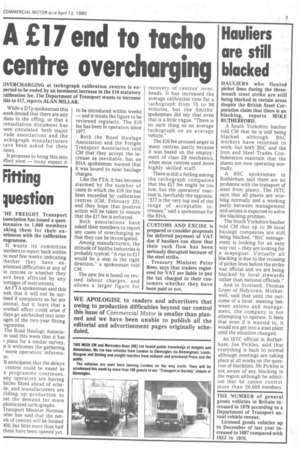A £17 end to 'Who centre overcharging
Page 5

If you've noticed an error in this article please click here to report it so we can fix it.
OVERCHARGING at tachograph calibration centres is expected to be ended by an imminent increase in the £10 statutory calibration fee. The Department of Transport wants to increase this to £17, reports ALAN MILLAR.
While a Dip spokesman this Neek denied that there are any )1ans in the offing, or that a 1..onsu1tation document has )een circulated, both major :rade associations and the .achograph manufacturers lave been asked for their riews.
It proposes to bring this into !ffect soon — many expect it to be introduced within weeks — and it wants the figure to be reviewed regularly. The £10 fee has been in operation since 1977.
Both the Road Haulage Association and the Freight Transport Association told CM that they accept the increase as inevitable, but an RHA spokesman warned that it was bound to raise haulage charges.
Like the FTA, it has become alarmed by the number of cases in which the E10 fee has been exceeded by calibration centres (CM, February 23), and they hope that positive action will be taken to ensure that the £17 fee is enforced.
Both associations have asked their members to report. any cases of overcharging so that they can be investigated.
Among manufacturers, the attitude of Smiths Industries is probably typical: "A rise to E.17 would be a step in the right direction," a spokesman told CM.
The new fee is based on revised labour charges, and allows a larger figure for recovery of centres' overheads. It has increased the average calibration time for a tachograph from 75 to 90 minutes, but the Smiths' spokesman did say that even that is a little vague. "There is no such thing as an average tachograph on an average vehicle."
The E10 fee aroused anger in many centres, partly because it was based on the employment of class 2B mechanics, when most centres used more highly skilled staff.
There is still a feeling among the tachograph companies that the -E17 fee might be too low, but the operators' reaction is, inevitably the opposite. "E17 is the very top end of the range of acceptable increases," said a spokesman for the RHA.
















































































